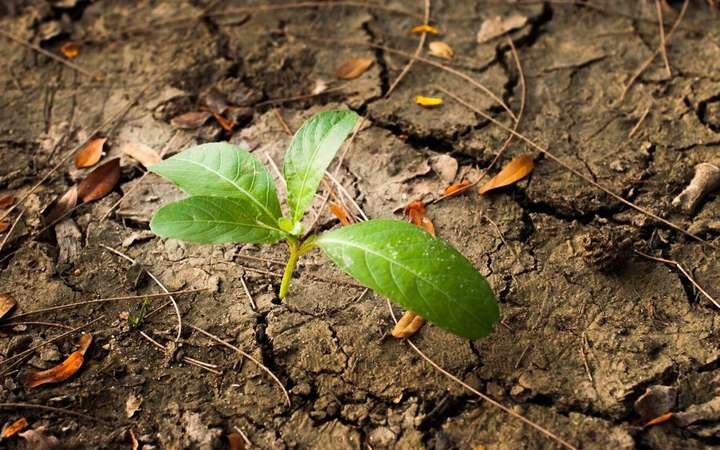On dangerous ground—land degradation is turning soils into deserts
March 28, 2018 by Abbas El-Zein, The Conversation

Free google picture
If any of us still has the slightest doubt that we are facing an ecological crisis on an unprecedented scale, then a new report on land degradation, released this week by the Intergovernmental Science-Policy Platform on Biodiversity and Ecosystem Services (IPBES), provides yet another piece of evidence.
Land degradation can take many forms, but always entails a serious disruption of a healthy balance between five key ecosystem functions. These are: food production; fibre provision; microclimate regulation; water retention; and carbon storage.
Its impacts can be far-reaching, including loss of soil fertility, destruction of species habitat and biodiversity, soil erosion, and excessive nutrient runoff into lakes.
Land degradation also has serious knock-on effects for humans, such as malnutrition, disease, forced migration, cultural damage, and even war.
At its worst, land degradation can result in the desertification or abandonment of land (or both). Protracted drought and loss of fertile land may have been contributing factors in the wars in Sudan and Syria.
According to the new report, 43% of world populations live in regions affected by land degradation. By 2050, the report estimates, 4 billion people will be living in drylands. These are defined by the United Nations as land with an "aridity ratio" of less than 0.65, meaning that the amount of water lost far outweighs the amount received in precipitation.
Such areas are highly vulnerable to food and water insecurity, especially in sub-Saharan Africa and the Middle East.
A global threat
It would be wrong to infer that land degradation is purely a problem for developing countries. Overall, land is generally more degraded in the developed world – as shown, for example, by greater declines in soil organic carbon content, a measure of soil health. However, in richer nations the rate of degradation has slowed, and people in these regions are generally less vulnerable to its effects.
It is in sub-Saharan Africa, Asia and South and Central America that the problem is growing most rapidly. But climate change, especially where droughts and forest fires are becoming more frequent, can cause land degradation even in affluent places such as California and Australia.
What's more, a decline in the overall availability of agricultural land is bound to affect food prices globally. By 2050, the report states, humans will have transformed almost every part of the planet, apart from uninhabitable stretches such as deserts, mountains, tundra and polar regions.
Perhaps most chillingly, the report predicts that the combined effects of land degradation and climate change will have displaced between 50 million and 700 million people by 2050, potentially triggering conflict over disputed land.
Some of this migration will inevitably be across international borders – how much is impossible to tell. While the impacts on migrants are almost always devastating, the ripple effects, as we have seen recently with the Syrian war, can spread far and wide, affecting electoral outcomes, border controls and social security systems throughout the world.
Globalised causes
The two most significant direct causes of land degradation are the conversion of native vegetation into crop and grazing lands, and unsustainable land-management practices. Other factors include the effects of climate change and loss of land to urbanisation, infrastructure and mining.
However, the underlying driver of all these changes is rising per-capita demand from growing populations for protein, fibre and bioenergy. This in turn leads to more demand for land and further encroachment into areas with marginal soils.
Market deregulation, which has been a global trend since the 1980s, can lead to the destruction of sustainable land management practices in favour of monocultures, and can encourage a race to the bottom as far as environmental protection is concerned. The vast geographical distance between demand for consumer goods and the land needed to produce them – between, in other words, the cause of land degradation and its effect – makes it much harder to address the problem politically.
Sadly, the timid history of attempts to create global governance regimes over the past century – from human rights, to conflict prevention, arms control, social protections and environmental treaties – has seen more failures than successes.
On the positive side, success stories in land management are well documented: agroforestry, conservation agriculture, soil fertility management, regeneration and water conservation. In fact, the new report states that the economic case for land restoration is strong, with benefits averaging ten times the costs, even when looking at very different types of lands and communities of flora and fauna. A common feature of many of these success stories is major involvement by indigenous populations and local farmers.
And yet these achievements remain far short of the scope of the problem. Significant obstacles remain – including, according to the report, increasing demand for land, lack of awareness of the extent of land degradation, fragmented decision-making within and between countries, and increased costs of restoration as time goes by.
On the other hand, the report's authors emphasise that a host of existing multilateral agreements, including conventions on desertification, climate change, biodiversity and wetlands, provide a strong platform for combating land degradation. However, whether these agreements will be successful in overcoming the obstacles mentioned above remains to be seen.
What can we do as citizens, especially those of us who live in cities and have little direct interaction with the land? The most obvious action is to eat less meat and, more generally, to inform ourselves about the sources and impacts of the food we buy – including its packaging, fuel and transport.
But the problem is not just about individual choices, important as these are. Underlying systemic causes need to be addressed, including deregulated international trading systems, lack of protection for local communities powerless to resist global market forces, ideologies of unfettered growth and perverse incentives for more consumption.
Arguably, what is needed is a broadening of the active scope of national politics, from an almost exclusive concern with short-term economic well-being to the making of global futures. Next time you meet your local representative, ask them what they are doing to protect the interests of your children and grandchildren. Or, even better, inform yourself, talk to others about it, form your own opinion about what should be done, then try to make it happen.
Source: https://phys.org/news/2018-03-dangerous-groundland-degradation-soils.html
I follow all the people who follows me! (If I have time, enough bandwidth and steem power...)

My 10 favorite posts:
 Boob morning! Thanks to my followers and upvoters! My gift:
Boob morning! Thanks to my followers and upvoters! My gift:
 SteemIt Daily report : 66 upvotes for my followers and 1986 members followed on Wed Mar 28 2018 ! See details
SteemIt Daily report : 66 upvotes for my followers and 1986 members followed on Wed Mar 28 2018 ! See details
 The tragic story of America's only native parrot, now extinct for 100 years
The tragic story of America's only native parrot, now extinct for 100 years
 SteemIt Daily report : 95 upvotes for my followers and 109 members followed on Wed Mar 28 2018 ! See details
SteemIt Daily report : 95 upvotes for my followers and 109 members followed on Wed Mar 28 2018 ! See details
 Degradation of soil: scientists sound the alarm
Degradation of soil: scientists sound the alarm
 Boob morning! Thanks to my followers and upvoters! My gift:
Boob morning! Thanks to my followers and upvoters! My gift:


 SteemIt Daily report : 62 upvotes for my followers and 1527 members followed on Wed Mar 27 2018 ! See details
SteemIt Daily report : 62 upvotes for my followers and 1527 members followed on Wed Mar 27 2018 ! See details
 Boob morning! Thanks to my followers and upvoters! My gift:
Boob morning! Thanks to my followers and upvoters! My gift:




All the pictures posted here are free pictures found on free websites, public instagram accounts or from websites allowing the sharing of their posts
Reproduction rights CC BY-NC-SA (Attribution - Sharing under the same conditions)
Greetings @mybestnews! Your post was chosen at random and was resteemed as part of Shareables' campaign. Enjoy your free resteem!
@Shareables, we resteem anything we find shareable. Always strive for quality content. Go on express and harness your blogging potential!
God bless from us @Shareables!
Downvoting a post can decrease pending rewards and make it less visible. Common reasons:
Submit